

Hydrocephalus
Silvia Helena Cardoso, MSc, PhD
The cerebro-spinal fluid (CSF) is produced constantly inside each of the four spaces or ventricles inside the brain. It normally
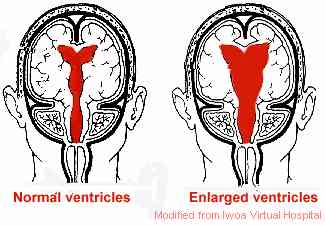 In
normal people it flows through narrow pathways from one ventricle to the
next, then out over the outside of the brain and down the spinal cord and
into the blood. If the drainage pathways are obstructed at any point, the
fluid accumulates in the ventricles inside the brain, causing them to swell
- resulting in compression of surrounding tissue. In babies and infants,
the head will enlarge. In older children and adults, the head size cannot
increase as the bones which form the skull are completely joined together.
In
normal people it flows through narrow pathways from one ventricle to the
next, then out over the outside of the brain and down the spinal cord and
into the blood. If the drainage pathways are obstructed at any point, the
fluid accumulates in the ventricles inside the brain, causing them to swell
- resulting in compression of surrounding tissue. In babies and infants,
the head will enlarge. In older children and adults, the head size cannot
increase as the bones which form the skull are completely joined together.
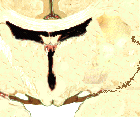 Lateral ventricles. Normal coronal section |
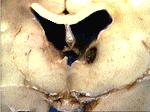 Lateral ventricles. Coronal section enlarged in a case of hydrocephalus |
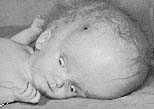 hydrocephalus in 14-month- old infant. Enlargement of the head, associated with the accumulation of CSF within the ventricles of the brain. Source: Correlative Neuroanatomy & Functional Neurology. |
Hydrocephalus is commonly known as 'water
on the brain', although this is not accurate. It is the condition where
the fluid spaces in the brain (ventricles) become enlarged. The
ventricular system dilates when CSF flow is obstructed. |
Types of hydrocephalus:
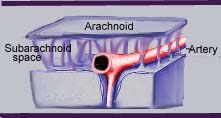 Communicating
Hydrocephalus - Obstruction to CSF flow in
the subarachnoid space after exit from fourth ventricle. Causes include
infection such as meningitis (fibrosis obstructs the subarachnoid space
and obstructs CSF flow), abnormal aging and absorption failur, subarachnoid
hemorrhage, or Blockage with blood from ruptured aneurysms.
Communicating
Hydrocephalus - Obstruction to CSF flow in
the subarachnoid space after exit from fourth ventricle. Causes include
infection such as meningitis (fibrosis obstructs the subarachnoid space
and obstructs CSF flow), abnormal aging and absorption failur, subarachnoid
hemorrhage, or Blockage with blood from ruptured aneurysms.
Non-Communicating Hydrocephalus - Obstruction to CSF flow within ventricular system or at outlet foramina. Sites of narrowing are commonly obstructed. Examples include Colloid Cysts which obstruct the 3rd ventricle, and tumors of the brainstem with compress the channel between the 3rd and 4th ventricle (Aqueduct of Sylvius).
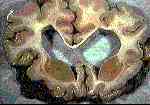 Hydrocephalus
Ex-Vacuo: Sometimes the brain will
shrink in size (as is seen in Alzheimer's Disease), and as a result, the
ventricles will enlarge to compensate. Thus though the ventricles are enlarged,
they are not under any pressure.
Hydrocephalus
Ex-Vacuo: Sometimes the brain will
shrink in size (as is seen in Alzheimer's Disease), and as a result, the
ventricles will enlarge to compensate. Thus though the ventricles are enlarged,
they are not under any pressure.
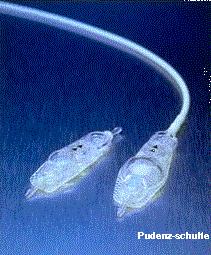 Shunts
- The most common treatment for hydrocephalus
is a shunt - a thin plastic tube inserted entirely under the skin that
creates a new path for the CSF, from the brain to another part of the body.
Shunting controls the pressure by draining excess CSF, so preventing the
condition becoming worse. However, shunts does not cure the hydrocephalus
and damage to the brain tissue remains. Shunts are not perfect, they may
malfunction, clog, may cause infection or may break.
Shunts
- The most common treatment for hydrocephalus
is a shunt - a thin plastic tube inserted entirely under the skin that
creates a new path for the CSF, from the brain to another part of the body.
Shunting controls the pressure by draining excess CSF, so preventing the
condition becoming worse. However, shunts does not cure the hydrocephalus
and damage to the brain tissue remains. Shunts are not perfect, they may
malfunction, clog, may cause infection or may break.
See:
Author: Silvia Helena Cardoso, PhD. Psychobiologist, master and doctor in Sciences by the University of São Paulo and post doctoral fellowship by the University of California, Los Angeles. Invited Professor and Associate Researcher of the Center for Biomedical Inofrmatics, State University of Campinas (Unicamp), Brazil. Correspondence